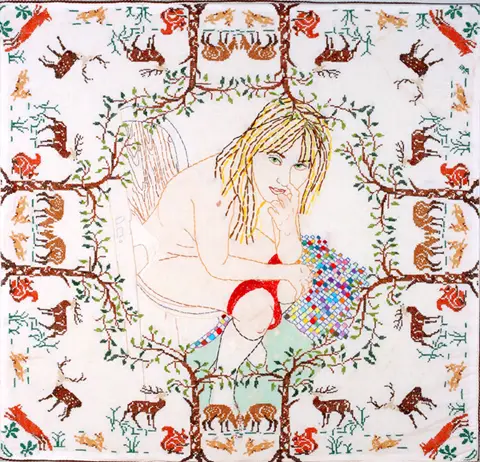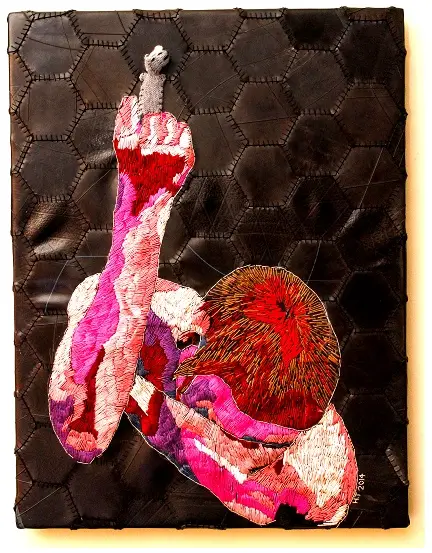
Hello, Fibristas and Fibristos! Go put on a beaded head band, pour yourself a glass of purple kool-aid, and rev up the record player with some Jefferson Airplane. Today we’re going to explore “Hippie” Embroidery.
Okay, here’s the scholarly, “you will be educated”* part first:
Needlework used to be considered a dedicated skill, an artform and a necessity. Fortunes were paid for the finest laces, gold work used real gold. Silks, cottons and velvets were the bulk of cargo from the East. Guilds monitored proficiency, set standards, trained and educated. Homes and bodies, churches and palaces of power were all adorned with the finest needle arts. The Industrial Age came screeching in, dirty, rough and mechanical. Handwork became at worst a sign of the poor, at best for “the lady at home”. A few artists paid tribute, designing and encouraging a return to quality handwork, for art’s sake as well as function, but aimed within a small wealthy sphere. Then came WW2 and a backward swing to mass produced again. It wasn’t until the late 50’s, the 60’s and 70’s that fibre artists started coming into their own, treating the stitch as an art medium. Amidst the macrame, felt cut out “holiday ornaments” and abominable ponchos, were the starts of quilting beyond covering a bed with traditional patterning, clothing that fit properly and was one of a kind, well made and well designed, three dimensional forms that defied our notion of what sculpture should be, embroidery that was original, and methods and materials becoming as important as the finished work. A needlework Renaissance was happening, hand work valued and respected again.
Now the funk and flash part (with apologies and a tip o’ the headband to Alexandra Jacopetti):
So what characterizes “Hippie” embroidery? Highly individualistic design, exuberant colour sense, subject matter: no kits, no colour “rules”, no holds barred, from the sacred and profane, to the weird and the wonderful. There’s nothing formal about the concept or the execution. Go ahead, embroider what you see while having an orgasm, a pop icon, nature unbridled and uncut, personal and universal symbols and signs; it’s all fair game. Translate your journal pages, your favourite sayings, your sketchbook. Deliberately and freely make mistakes in perspective and technique. There’s something very liberating and personally satisfying about sitting with a needle and thread and an expanse of virgin cloth, just letting things happen as they will! On a side note, from my crawl around the interwebs, adding fringe, Indian coins or the word GROOVY does not necessarily make it hippie. Neither do marijuana leaves—we smoked it in those days, we didn’t embroider it.
I was surprised to find *very* few images on line of what would truly be described as Hippie Embroidery! It’s sad to think so much of it is gone, but wear and tear and new sensibilities probably saw it tossed as garbage….There were cheesy sanitized cop-out digital designs, commercial sites selling Gen-U-Wine Mexican huipils and wedding shirts, vintagey crap and i’m sorry, a lot of *bad* embroidery, but real examples are sorely lacking. The best were from Flickr, and some of them may not be categorized by their Makers as “hippie” but i think they capture the sensibility perfectly. There’s a definite resurgence of this style!
Emmy Schoonbeek (Cramzy):
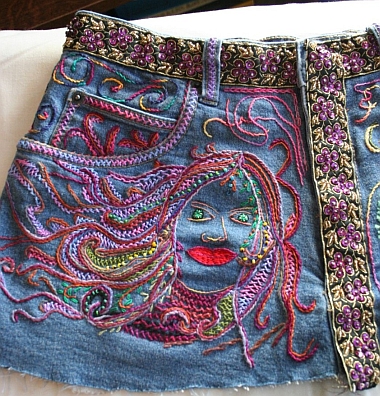
Susan Sorrell (CreativeChick):
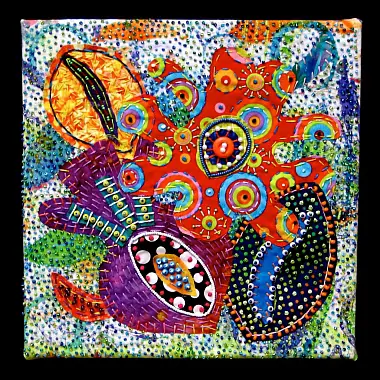
Diane Cransac (Cymberrain):
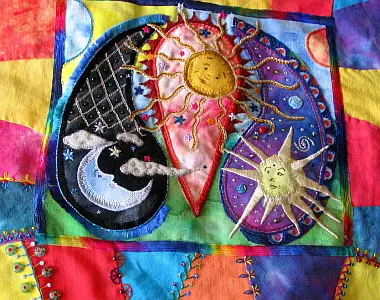
Becky Loew (Cosmicarcata):
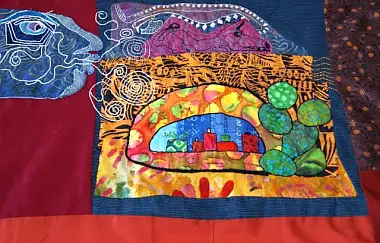
Wayward Radish:
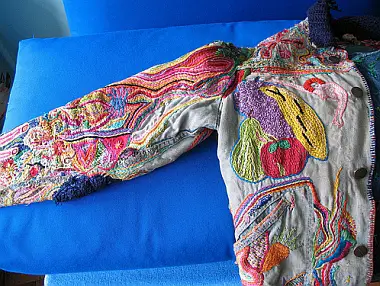
And what else makes an embroidery “Hippie”? A spontaneous use of ethnic or personally historied fabrics, well chosen beads and Shisha. Shisha is actually very easy to do and there are several methods. Use the small mirror pieces from the dollar store/pound shop/craft supplier or flat paillette sequins. Or you can fake it with little circles of glitzy cloth fused to a heavier backing! ( I can email instructions to those who are fusing challenged.)
Want to go ethnic hippie with your clothing? Try Folkwear patterns, or the modern DIY hippie wardrobe. The best “bases” are thrifted wear or from Mom’s/Gramma’s closet! Three books i recommend, though you may only find them in a used bookstore, are Alexandra Jacopetti’s “Native Funk and Flash” (the BIBLE for this era, and Ms Jacopetti was instrumental in starting Folkwear patterns), Jean Ray Laury/Joyce Aiken’s ‘Creating Body Coverings” and Peter S. Beagle’s “American Denim”, all of which were published in the 70’s. (I am lucky enough to own the first two!) You might also be able to find the more current “Hippie Crafts” by Joanne O’Sullivan, though it’s rather white bread.
If you score any vintage patterns from the era, remember sizing is different now. I have info here about how to buy the right size, or adjust it if you’re talented/brave enough!
*If you are interested in the importance of the genre as an art form, go read this. I personally take exception to this line “These handmade expressions require patience to complete, as the craft is tedious.”—-Yes, definitely patience, but tedious???? Part of the process for us Embroiderers IS the process! However, this one really resonates: “… embroidery’s rare association with love is what makes it unique and appealing.”
So, go forth, with needle and thread, and love, my young hippies. Find your Magic Bus, er, Hoop. Peace!


